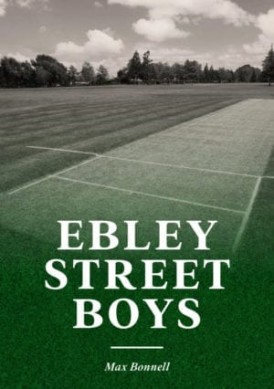Ebley Street Boys
Archie Mac |Published: 2019
Pages: 106
Author: Bonnell, Max
Publisher: Bonnell, Max
Rating: 4 stars

It is probable that only the real cricket connoisseur will have heard of the two players featured in Ebley Street Boys. This is not a surprise as neither Norman Callaway nor Frank O’Keeffe played Test cricket, and both were born in 1896. Even then most will probably only know them through the fact both players sometimes pop up in an all time XIs and, under different circumstances, might have played Test cricket for Australia.
The reason these two make these lists is no real surprise. Callaway batted once in First Class cricket and scored 207, while O’Keeffe played nine matches and averaged 71.23. Great averages, which makes the cricket tragic think about what might have been.
As the title suggests both players lived, although briefly, in the same Ebley Street in Sydney and as such played for the same district club. Despite these associations Max Bonnell is unsure if they were anything other than acquaintances and surmises that given their very different personalities they were most likely not friends. They enlisted separately in the Great War which further suggests they were not close mates. Being too young both players had to put their age up so they could join the armed forces.
Despite their brief First Class cricketing careers Bonnell presents an engrossing and in the end a rather melancholy cricketing story. As in his fine biography of another Great War casualty, ‘Tibby’ Cotter, Bonnell’s coverage of the players’ time in the trenches makes for a quality read.
The book starts with the formative years of Callaway, and perhaps for this reason you feel more involved in his narrative, especially in the first half of the book. The author’s research cannot be criticised, and notwithstanding his efforts Bonnell freely admits to not having a lot of information on the personality of Callaway. Still he manages to draw you in enough that you will be left shaking your head at the pointless loss of a young man killed in his prime over a few yards of turf.
O’Keeffe, despite seeing his fair share of fighting, survives the war. Before the hostilities O’Keeffe struggles to hold down a place in Sydney first grade cricket and nothing appears to have changed directly after the conflict. He was not considered good enough to play for the strong Waverley team, but was thrown a lifeline by Paddington.
At his new club O’Keeffe suddenly struck a purple patch and on the back of one stellar bowling performance was surprisingly given a chance to debut with NSW. He took the opportunity with both hands and quickly established himself as a leading player. Bonnell makes the point that were it not for a lack of Test matches scheduled at the time, O’Keeffe would have won an Australian cap.
The exact reason for O’Keeffe’s meteoric rise is not totally clear. Perhaps it was because he was blessed with tremendous confidence in his own ability and he also, unusually for the period, spent a lot of time practising and keeping himself in peak physical condition.
Whatever the reason O’Keeffe, after a successful move to Victoria, decided to take his chances in England, but unfortunately just before his Lancashire debut he died. Bonnell conjectures that his illness was directly related to the Great War, and his arguments seem valid.
This is a charming little book, well researched and written. The only issue is the lack of quality photographs of both players, but this is understandable given the brief lives and cricketing spans of both men. I did chuckle at one of the group photos; the caption reads O’Keeffe, (with pipe). Three of the four men in the photo have pipes. This humorous goof, and some untidy score card formatting are the only, very minor, errors in a quality read – highly recommended.






Leave a comment